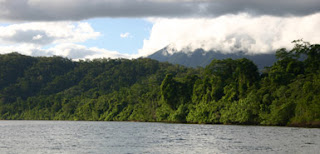 Climate change may lead to lush growth rather than catastrophic tree loss in the Amazonian forests, researchers from the US and Brazil have found. A study, in the journal Science, found that reduced rainfall had led to greener forests, possibly because sunlight levels are higher when there are fewer rainclouds.But scientists cautioned that while the finding raises hopes for the survival of the forests, there are still serious threats. Climate models have suggested that the forests will suffer as the region becomes drier and will release huge quantities of carbon dioxide into the atmosphere.Climate models have suggested in the past that the Amazon will suffer enormous die-backs as the region becomes drier and will release huge quantities of carbon dioxide into the atmosphere. Deforestation is calculated to be one of the main contributors to the rising carbon dioxide levels that are widely held by the scientific community to be causing global warming. The loss of the Amazon would cause enormous quantities of carbon dioxide stored in the vegetation to be released back into the atmosphere, intensifying the warming effect. Researchers identified the greener regions of the Amazon after analysing satelite images and comparing them to rainfall records. The 2005 drought provided them with “a unique opportunity to compare actual forest drought response to expectation”.They said: “Large-scale numerical models that simulate the interactions between changing global climate and terrestrial vegetation predict substantial carbon loss from tropical ecosystems including the drought-induced collapse of the Amazon forest and conversion to savanna.“If drought were to have the expected negative effect on canopy photosynthesis, it should have been especially observable during this period.“The observations of intact forest canopy ‘greenness’ in the drought region, however, are dominated by a sgnificant increase, not a decline.”Growth spurts would be “inconsistent with expectation”, they reported in the journal Science, and concluded the reduced rainfall was more than compensated for by extra sunlight.“These observations suggest that intact Amazon forests may be more resilient than many ecosystem models assume, at least in response to short-term climatic anomolies,” they added.Further studies will be needed to assess the long-term impacts of changing weather patterns on the Amazon and other forest regions from factors including strong el Nino events and long-term climate change.Deforestation from logging, legal and illegal, and fires were cited as other threats to the condition of the Amazon forests, especially as the areas pinponted as being in the steepest decline were those that were “heavily impacted by human activites”.The paper 'Amazon Forests Green-Up During 2005 Drought' was written by Scott R. Saleska, Kamel Didan, Alfredo R. Huete and Humberto R. da Rocha.
Climate change may lead to lush growth rather than catastrophic tree loss in the Amazonian forests, researchers from the US and Brazil have found. A study, in the journal Science, found that reduced rainfall had led to greener forests, possibly because sunlight levels are higher when there are fewer rainclouds.But scientists cautioned that while the finding raises hopes for the survival of the forests, there are still serious threats. Climate models have suggested that the forests will suffer as the region becomes drier and will release huge quantities of carbon dioxide into the atmosphere.Climate models have suggested in the past that the Amazon will suffer enormous die-backs as the region becomes drier and will release huge quantities of carbon dioxide into the atmosphere. Deforestation is calculated to be one of the main contributors to the rising carbon dioxide levels that are widely held by the scientific community to be causing global warming. The loss of the Amazon would cause enormous quantities of carbon dioxide stored in the vegetation to be released back into the atmosphere, intensifying the warming effect. Researchers identified the greener regions of the Amazon after analysing satelite images and comparing them to rainfall records. The 2005 drought provided them with “a unique opportunity to compare actual forest drought response to expectation”.They said: “Large-scale numerical models that simulate the interactions between changing global climate and terrestrial vegetation predict substantial carbon loss from tropical ecosystems including the drought-induced collapse of the Amazon forest and conversion to savanna.“If drought were to have the expected negative effect on canopy photosynthesis, it should have been especially observable during this period.“The observations of intact forest canopy ‘greenness’ in the drought region, however, are dominated by a sgnificant increase, not a decline.”Growth spurts would be “inconsistent with expectation”, they reported in the journal Science, and concluded the reduced rainfall was more than compensated for by extra sunlight.“These observations suggest that intact Amazon forests may be more resilient than many ecosystem models assume, at least in response to short-term climatic anomolies,” they added.Further studies will be needed to assess the long-term impacts of changing weather patterns on the Amazon and other forest regions from factors including strong el Nino events and long-term climate change.Deforestation from logging, legal and illegal, and fires were cited as other threats to the condition of the Amazon forests, especially as the areas pinponted as being in the steepest decline were those that were “heavily impacted by human activites”.The paper 'Amazon Forests Green-Up During 2005 Drought' was written by Scott R. Saleska, Kamel Didan, Alfredo R. Huete and Humberto R. da Rocha. As in the days of Noah....






















































































.bmp)

























.bmp)